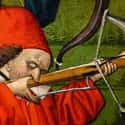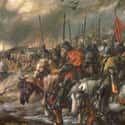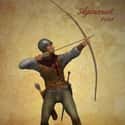-
(#1) The French King Was Insane
When Charles VI became the King of France in 1380, he was just a child. His uncles and an administrative council ruled France with him until he took over personal rule in 1388. Despite showing some talent in fighting at the chivalric tournaments of the time, he also suffered from fits of madness and delusions. His periods of insanity, which lasted for months at a time, began after he had a high fever in 1392 and plagued him for the rest of his life. He often believed himself to be made of glass and, as a result, would not move for fear of shattering. He had metal stints sewn into his clothes and wrapped himself in fabric to keep from breaking, as well.
-
(#2) The French Nobles Were Fighting Each Other
With a weak king, aristocratic aspirations were at their peak. During a break in the fighting with England, French nobility - namely the Dukes of Orleans and Burgundy - vied with one another for land and influence at the royal court. Charles VI’s brother, Louis, the Duke of Orleans, purchased a significant portion of land in Burgundy in 1402. The land, which Burgundy considered private and not for sale, was purchased with the money Louis drew from his royal income. Louis’s enemies responded – not only in support of Burgundy, but also to undercut the power of the King’s brother blaming increased taxation on Louis’s excess.
Louis was assassinated in 1407 as the rivalry became more volatile. Louis’s son, Charles of Orleans, responded by making any and all allies of Burgundy his enemies, launching a 30-year civil war between the two sides.
-
(#3) The French Aristocracy Suffered From Warrior Elitism
The French aristocracy, deeply engrained in chivalric values, feudal tradition, and concerned for their status in politics and society, refused to fight with the peasantry against the English. Despite several thousand peasants coming together and wanting to fight, the aristocracy didn’t want to take the risk of arming them lest they should revolt, nor did they want to lose out on their own chance for glory on the battlefield. There were several hundred peasants present at Agincourt in the end, but they were relegated to the rear guard and were either unwilling or not allowed to fight.
-
(#4) The French Leaders and Soldiers Got Cocky
The French outnumbered the English with anywhere from 12,000 to 36,000 troops to their 5,000, depending on which source one believes. The English troops were weak and weary, solemn and resolute the night before the battle. The English had been beaten down by disease, lack of food, and threats of French counterattacks since they'd arrived in France in August 1415. On the eve of Agincourt, Henry V ordered his men to remain completely silent, for fear of a surprise attack by the French. Meanwhile, their French counterparts drank and rabble-roused, certain of their impending victory.
-
(#5) The French Knights Were Weighed Down By Their Expensive Armor
The French knights wore heavy plate armor, as did their horses. With over 100 pounds of metal covering their bodies, they were hampered in terms of swift movement and limited when it was time to get off of their horses and engage in hand-to-hand combat. The English, for their part, wore lighter leather and chain mail armor, if any at all.
-
(#6) The French Army Feared Yet Continued To Underestimate English Longbows
The biggest problem for the French was their lack of longbows. The English archers dominated earlier battles of the Hundred Years’ War with their superior bows and the same weapons controlled Agincourt. An English longbowman could shoot up to 10-12 arrows a minute. The longbow hurled arrows as far as 400 yards. The arrows could pierce plate armor and shields alike from between 100 and 200 yards away.
According to legend, the French so feared the longbow that they threatened to cut off the first two fingers of any English archer captured in battle. This would prevent him from ever firing an arrow again. Given the success of the English, the archers began waving their first two fingers at the French as a taunt on the battlefield.
-
(#7) The French Leaders Tried To Match The English, But It Was Too Late
Boucicault had experience fighting the English and was determined to counter the English longbowmen at Agincourt. He had a plan in place to advance upon the French with his knights while sending crossbowmen around the English flanks. Unfortunately, the battlefield was too narrow for Boucicault to execute his strategy and his knights ended up bottlenecked and trapped.
Because the French aristocracy, mainly knights on horseback, didn’t allow for their inferiors to have weapons, the French army relied heavily on light and heavy cavalry. At the Battle of Agincourt, the French commander Jean II Le Maingre, also known as Boucicault, had Genoese crossbowmen to accompany his forces, but generally speaking, the French lacked the tactics needed to match their English enemy. -
(#8) The French Army Should Have Stayed On Defense
On the morning of October 25 near Agincourt, the French and the English troops stood and stared at each other for three hours. Both sides intended to stay on the defensive and hold their positions, but Henry V got impatient and started the battle. (His speech prior to the battle, made famous by Shakespeare, was an invention of the Bard, but remains a symbol of English nationalism.)
The English advanced, getting close enough to the French lines to barrage them with arrows. This drew out the French cavalry – a cavalry advance that took place without orders - and destroyed thousands of French troops in minutes.
According to the chronicle of Enguerrand de Monstrelet, a supporter of the French, troops "had their horses so severely handled by the archers... the horses were becoming unmanageable, so that the horses and riders were tumbling on the ground, and the whole army was thrown into disorder."
-
(#9) The French Knights Were Mired In Mud
The heavy French armor was an even bigger problem, given the state of the battlefield. After days of rain, the field at Agincourt was wet, muddy, and difficult to traverse. When the French knights were on their horses, the horses struggled to get through the terrain. When the French knights were on foot, they got stuck, weighed down, and even drowned as they sank into the mud. Once the bottleneck of French troops began to trample each other, the mud further complicated any chance of movement, much less escape.
-
(#10) The French Knights Trampled Each Other
In the midst of a narrow battlefield, panicked men and horses, and inescapable mud, the French began to trample one another. They were trapped by their tight formations and as the men in the rear advanced, there was nowhere for the men in the front to go except into the battle-ready hands of the English. When a longbowman ran out of arrows, he'd use his sword or ax and hand-to-hand combat ensued. The vulnerable, iron-laden French knight, fresh off of his horse and sinking into the ground, found himself at the mercy of the quicker and more nimble English soldier.
-
(#11) The French Army Was Waiting On More Men
Boucicault, the Duke of Orleans, and the French army were waiting for reinforcements, despite already outnumbering the English as much as 6 to 1. The brother of the Duke of Burgundy, the Duke of Brabant, got word that the battle had started and immediately set off with some of his men to fight with his French comrades. Unfortunately, he was two hours away and by the time he arrived, the battle was well under way. In a rush, Brabant grabbed the weapons and armor of one of the fallen French men-at-arms and made his way to the battlefield. His men seemed to reinvigorate the French troops briefly, but the English remained dominate. Unfortunately for Brabant, the armor he’d put on was that of a lesser noble and once the battle was over, he was taken prisoner and killed, being deemed unworthy of holding for ransom.
-
(#12) The French Knights Couldn't Kill the English King
The French got really close to killing King Henry V. Really, really close. In an advance late in the day, several French noblemen made a push toward the king, who was easily recognizable on the battlefield with his well-adorned armor. The French were able to take some swings at the king, slicing off the jewels on his crown, but failed to inflict any real physical damage. Had they been able to kill the enemy's leader, it would have been a clear and decisive victory for the French.
-
(#13) The French Losses Kept On Coming, Even After The Battle
At Agincourt, the English took thousands of French prisoners. Once the battle was complete, the English had no way to keep all of them alive, nor did they have any use for men that would not get them any ransom. As a result, many of the prisoners were gathered into a nearby barn, locked inside, and burned to death. Hundreds of others were slaughtered by English archers and men-at-arms. The French nobility was all but destroyed.
New Random Displays Display All By Ranking
About This Tool
Britain and France experienced nearly a hundred years of war confrontation from the 14th to the 15th centuries. On October 25, 1415, a fierce military conflict broke out in Agincourt, France. The two warring armies were the Royal Army of England led by Henry V and the Royal French Army under the command of Count Charles de Albrecht. The battle of Agincourt was a famous battle in the Hundred Years' War between Britain and France that wins more with less.
Under the leadership of Henry V, the British army, dominated by infantry archers, defeated the elite French army composed of a large number of nobles, laying the foundation for the capture of Normandy in 1419. This battle became one of the most brilliant victories for the British longbowmen. The random tool shares 13 historical facts about the battle of Agincourt.
Our data comes from Ranker, If you want to participate in the ranking of items displayed on this page, please click here.























